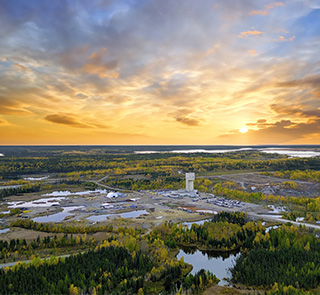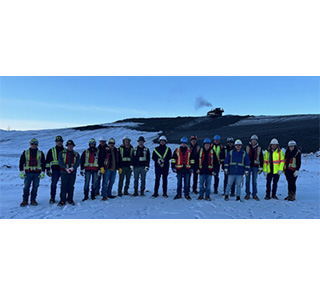X
For nominations, please contact your local chief mines inspector, or the John T. Ryan secretary Thomas Demorest at JohnTRyanSafetyTrophy@cim.org
The John T. Ryan Trophy was first introduced to the Canadian mining sector in 1941, and has now expanded globally to include; Chile (1996), Peru (1999), Colombia (2011), South Africa (2011), Argentina (2012) and Brazil (2012).
CIM supports the principle that mine safety is enhanced through friendly competition and public recognition of extraordinary results. The goal of the John T. Ryan Safety Trophies Program is to eliminate the suffering of miners and their families due to work injuries.
Trophies and awards are presented upon the recommendation of the John T. Ryan Safety Trophies Committee. This committee consists of the heads of the provincial and territorial mines inspections organizations, the heads of the provincial and territorial mining associations and certain ex-officio members. CIM Council appoints the Chairman and the Secretary of the Committee.
CIM Council presents trophies annually to the companies whose Canadian mines have achieved the lowest injury frequencies in their geographical and/or mineral sector during the previous calendar year.
THE TROPHIES AND AWARDS
The mining industry is divided into three mining sections: metal mines, select mines and coal mines. There is one Canada National Trophy for each of these sectors.
For metal mines, the industry is divided into four geographical regions: British Columbia and Yukon; the Prairie Provinces and Northwest Territories; Ontario; Quebec and the Maritime Provinces. There is one Regional Trophy for each of these regions.
For select mines, the industry is divided into two regions; Manitoba and the western provinces and territories; Ontario and the eastern provinces. There is one Regional Trophy for each of these regions.
This means that there are a total of nine trophies which may, on the recommendation of the Committee, be awarded annually.
In addition, “Special Award Certificates” will be awarded at the discretion of the Committee to companies which have exemplary safety records but which are not eligible for a trophy.
PRESENTATION OF THE TROPHIES AND AWARDS
The Canada National Trophies are presented at the CIM-Caterpillar Awards Gala during CIM CONNECT in May.
The Regional Trophies and Special Award Certificates are presented at a meeting of mining industry people deemed suitable by the members of the Committee.
The winning companies will hold the trophies for a period not exceeding one year, and will return the trophies at the time and to the place designated by the Committee. In the event that two or more companies are awarded a trophy jointly, the Committee will specify what part of the ensuing year each will hold the trophy.
DEFINITIONS
- A Metal mine is a mine producing metals from which at least two thirds of its production is derived from an underground operation.
- A Coal mine is any mine producing coal.
- A Select mine is any mine except Metal and Coal; for example, any open pit mine, oil sands operations, flat-bedded nonmetallic mineral deposits such as salt, potash or gypsum mines.
- A Reportable Injury is an injury requiring medical attention which prevents a worker from returning to his or her regular job on the day following the injury, or any full day subsequent to that day.
- A Lost Time Injury is an injury which requires the worker to stay home or be hospitalized on the day following the injury, or any full day subsequent to that day.
- A Modified Work Injury is an injury in which a medical professional, including doctors, nurse practitioners, nurses, and other qualified professional determines that a worker is capable of doing some useful work, but not all facets of the regular work being done before the injury.
- The Injury Rate is calculated by multiplying the number of Reportable Injuries by 200,000, and dividing by the number of hours worked in the unit of competition, for the competition period.
- A Unit of Competition is a mine or complex of mines together with the mill, office and shops used in conjunction with the mine. Smelters and refineries may be included with the mine if the number of employees is less than 50% of the total in the Unit. Companies operating more than one mine may include all their operations in one Unit, or divide their operations into several Units. Once the decision is made it may not be changed without the approval of the Committee.
- A company which employs mining contractors to do production work at the mine must include the contractors in its Unit. A mining contractor operating a mine, or doing development work, is itself eligible as a Unit of Competition.
- Hours worked by the Unit will include regular and overtime hours for salaried and hourly employees, in the calendar year for which the award is being made. Companies which do not have enough hours in one year to be eligible may accumulate the experience (hours and injuries) over more than one year.
ELIGIBILITY
Every company operating a mine in Canada is invited to submit an annual entry form, regardless of eligibility. The information contained in the form may be used in later years to determine eligibility for a Special Award Certificate.
A fatal injury in a calendar year makes a company ineligible.
An industrial disease, (such as hearing loss, white finger, cancer or other slowly developing disabilities) is not a reportable injury.
A Unit of Competition will have a minimum of 500,000 employee hours for metal and select mines, and 120,000 employee hours for coal mines, in one calendar year (Note: that smaller companies may accumulate hours over several calendar years).
ENTRY FORM
The Entry Form will be authorized by the Committee, and will be submitted in duplicate by companies to their Provincial or Territorial Representative for review.
The Form will indicate the number of hours worked by the Unit and the number of Lost Time and Modified Work Injuries; these numbers will be certified by the manager in charge of the Unit.
The forms will be returned to the Committee Secretary for Processing at least two months before CIM CONNECT in May.
SPECIAL NOTE
The John T. Ryan Safety Trophies Committee believes that safety program performance is best measured by the prevention of injuries serious enough to keep a worker from returning to his or her regular job the day following the injury. However, the Committee endorses the provision of Modified Work as part of a rehabilitation program designed to speed recovery of an injured worker and to reduce the economic impact on both the worker and the company. Modified Work is not provided to conceal injuries that should be reported, and in recognition of this fact, the Entry Form requires the reporting of both Lost Time and Modified Work injuries so that good work by companies is publicly acknowledged.
RECIPIENTS
There can be multiple recipients of this award every year. This award is solely for organization nominations.


 - dev.png)

